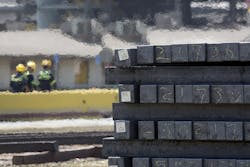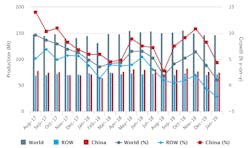The world’s steelmakers started the new year slightly ahead, with a total output of 146.7 million metric tons produced across 64 countries, about 250,000 metric tons (+0.16%) more than the December 2018 total and about 1.5 million metric tons (1.05%) more than in January 2018.
The results are in line with the "slow-but-steady growth" forecast by the World Steel Assn. in its late-2018 market forecast.
The World Steel Assn.’s monthly raw-steel production represents output from about 99% of the world’s raw-steel production output. Raw steel is the product of basic-oxygen and electric-arc furnaces, and cast into semi-finished products, like billets, blooms, and slabs. Most raw steel is produced on contract for large manufacturers, like automotive, appliance, and machinery builders. Less predictable is the amount produced for construction markets or for service centers and distributors.
China remains by far the largest steel-producing nation, with about half of the world’s operating capacity. The 75.01 million metric tons produced in China during January represents about 1.5% less than the December total but is a 4.35% improvement over the January 2018 result.
All of the other major steel-producing nations in the Asian region registered lower production totals for January: in Japan, steel tonnage fell -9.8% lower year-over-year; in India, -1.86%; and in South Korea, -1.52%
In the European Union, total regional (28 nations) raw-steel output was 13.8 million metric tons during January, 7.8% more than in December 2018 but 3.52% less than during January 2018. The Germany steel industry, the largest in the region, produced 3.4 million metric tons for the month, 5.7% more than during December but -3.52% less than during January 2018.
Italian steelmakers produced 1.96 million metric tons, 18.6% more than during December but -7.2% less than last January. In France, the January output of 1.2 million metric tons was up 9.9% over December but -9.7% off the total for January 2018. In Spain, steelmakers produced 1.18 million metric tons, 12.5% more than during December and 5.9% more than during January 2018.
Turkish steelmakers produced 2.56 million metric tons during January, which was down -11.12% from December’s total and -19.5% from the January 2018 total.
Russia’s steel industry had a January output of 5.8 million metric tons, up 9.9% from December and down -4.5% from January 2018. Ukrainian steelmakers produced 1.85 million metric tons during January, -1.9% off the December total and -4.9% off the January 2018 result.
Brazil’s raw-steel output for January 2019 was 2.9 million metric tons, up 10.9% over the December 2018 result and up 2.3% over January 2018.
Finally, U.S. steelmakers produced 7.6 million metric tons ( short tons) of raw steel during January 2019, which was 2.3% more than the December total and 11.0% more than the January 2018 output.

